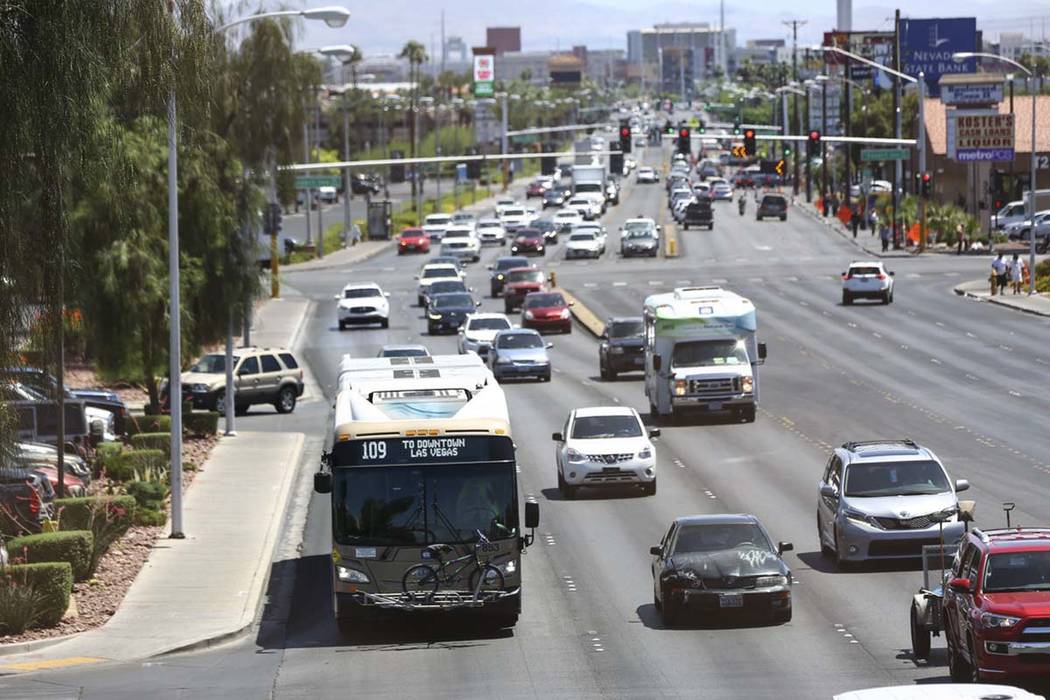RTC votes for bus system over light rail for Maryland Parkway
Local transit officials decided against building a $1 billion light rail system along the busy Maryland Parkway corridor Thursday, despite public support for the plan.
Instead, the Regional Transportation Commission of Southern Nevada board of commissioners voted unanimously in favor of a bus rapid transit system with an estimated cost of $345 million. The board also considered an enhanced Route 109 bus service that would have cost $29 million.
Cost factored into the board’s choice, as the prevalence of ride-hailing options and emerging technology such as autonomous vehicles and a possible underground system could affect ridership of any of the three choices.
“I haven’t been shy about the fact that I’ve been a champion of light rail in our community, but I’m also a fiscally responsible leader in our community, and I know we have to look at how we’re spending our resources,” said Henderson Mayor Debra March, who sits on the board. “Clearly the $1 billion is a significant price tag for the ability to provide service to provide better efficiencies to get people out of their cars.”
The estimated costs of the light rail and the bus rapid transit systems are higher than what was originally projected in 2016. David Swallow, the RTC’s senior director of engineering and technology, said the cost increase was largely due to the changing construction market over the past three years.
“We wanted to get an independent cost estimator, so we contracted with someone late last year,” Swallow said.
“As they looked at the demands of the market today, especially for the Southwest region of the U.S., the prices were coming in higher than they were before, particularly for the rail project.”
Bus rapid transit
The bus rapid transit system preferred by the RTC features an in-street design with dedicated bus lanes that can be used as turn lanes when buses are not present. The plan also calls for a bike lane off the main road, with the bus lane providing an added barrier between automobiles and bicyclists.
Each bus will be 60 feet long and able to carry up to 90 passengers. Stations will be spaced a third of a mile apart.
The system will be funded with $125 million from fuel revenue index taxes, $115 million from the Federal Transit Administration’s New Starts grant progam and $105 million from the federal Congestion Mitigation Air Quality program, RTC documents show.
The FTA New Starts grant is not a guaranteed source of funding, but Swallow said the bus rapid transit system is a strong contender for the money.
“For Maryland Parkway, the ridership is very strong, strong enough for a rail-based option,” he said. “We’re going with bus rapid, and with that it takes us a step further in making it more competitive against the other projects across the U.S.”
The RTC will need to apply for the grant in two different cycles in the summer of 2020 and then again in the summer of 2021.
Tentative plans call for construction to start in late 2022 and finish by the end of 2024, if the federal funding falls into place.
The Maryland Parkway route stretches 8.7 miles from near McCarran International Airport through a portion of downtown Las Vegas and ends up in the Las Vegas Medical District.
The route will link UNLV, several hospitals and medical centers and commercial and residential complexes.
Increased ridership
The RTC estimates more than 9,000 bus riders and 35,000 vehicles travel on Maryland Parkway daily.
With the bus rapid transit system, the RTC estimates bus ridership will increase to 13,300 in the opening year, versus light rail projections of 16,100.
Yearly operating and maintenance costs for the system are estimated at $8.3 million, with $4 million offset by fare revenue. The net operating cost of $4.3 million is actually $500,000 less per year than an enhanced Route 109 system, according to RTC data. Light rail would have seen an $8.5 million net operating cost, projections show.
Linking McCarran to the route was also a concern of several board members, as the light rail option would have tracks going over or under the airport’s roads, Swallow said.
“We would work with the Clark County Department of Aviation to see where they would want us to go,” he said. “We already have spaces set aside at the zero level of Terminal 1 and in Terminal 3, where we provide bus service today. Going forward with a bus rapid transit system, we look at it as where the existing Route 109 goes to today, the bus rapid can go tomorrow. But, if they want us to move somewhere, we’re happy to do that.”
Support for light rail
The board’s choice was in spite of the public’s overwhelmingly positive view of the light rail system, expressed to the RTC gathered through public meetings and online and mail-in submissions.
Of 1,002 submissions, 729 directly addressed the provided transportation choices, with 72 percent of residents choosing light rail as their preferred option. Bus rapid transit came in second with 13 percent of the vote.
Despite that, board member Larry Brown said the commission had to make a smart decision that factors in the future of transportation.
“We’re in, perhaps the first time in a long time, perhaps the first time ever, where we’re trying to figure out what transit is going to be, or the transit rider with what’s happened with Uber and Lyft,” he said.
“There’s also the backdrop of technology. Depending on what expert you talk to, some say (Elon Musk’s) Boring Co. is the future, some say light rail or European tram.”
The Boring Co. has proposed using autonomous electric vehicles in underground tunnels to move people. It proposes building a system linking different sections of the Las Vegas Convention Center as early as 2021, with plans to possibly incorporate the Resort Corridor and McCarran in the future.
“I absolutely believe that we have to do something,” Brown said. “But something that lowers the risk from a fiscal standpoint that gives us the flexibility, for as these changes come and go quickly over the next five years, we’re not locked into a strategy. I think the BRT option gives us that flexibility.”
Contact Mick Akers at makers@reviewjournal.com or 702-387-2920. Follow @mickakers on Twitter.
Climbing costs
The Regional Transportation Commission of Southern Nevada updated the projected costs of each of the three alternatives from what was originally estimated in 2016:
— Light rail jumped to $1 billion from $750 million;
— Bus rapid-transit plan jumped to $345 million from $335 million;
— Upgrading route 109 stayed steady at $29 million.























